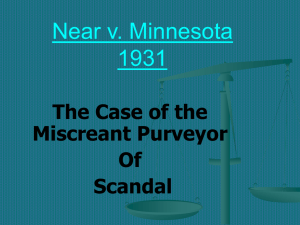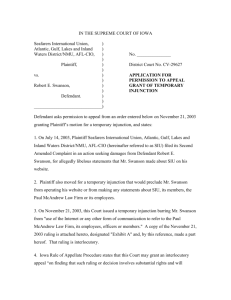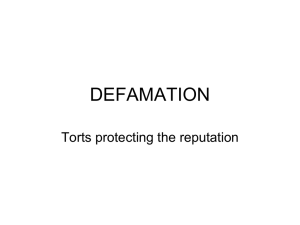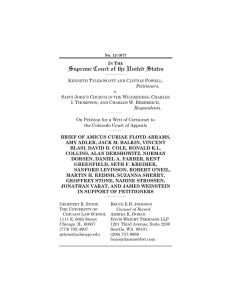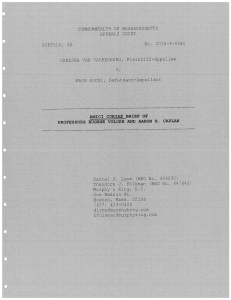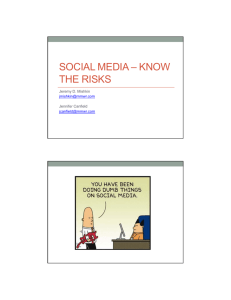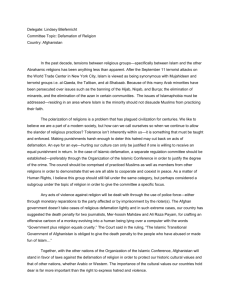NO. 14-3308 AND NO. 15-1839 UNITED STATES COURT OF
advertisement
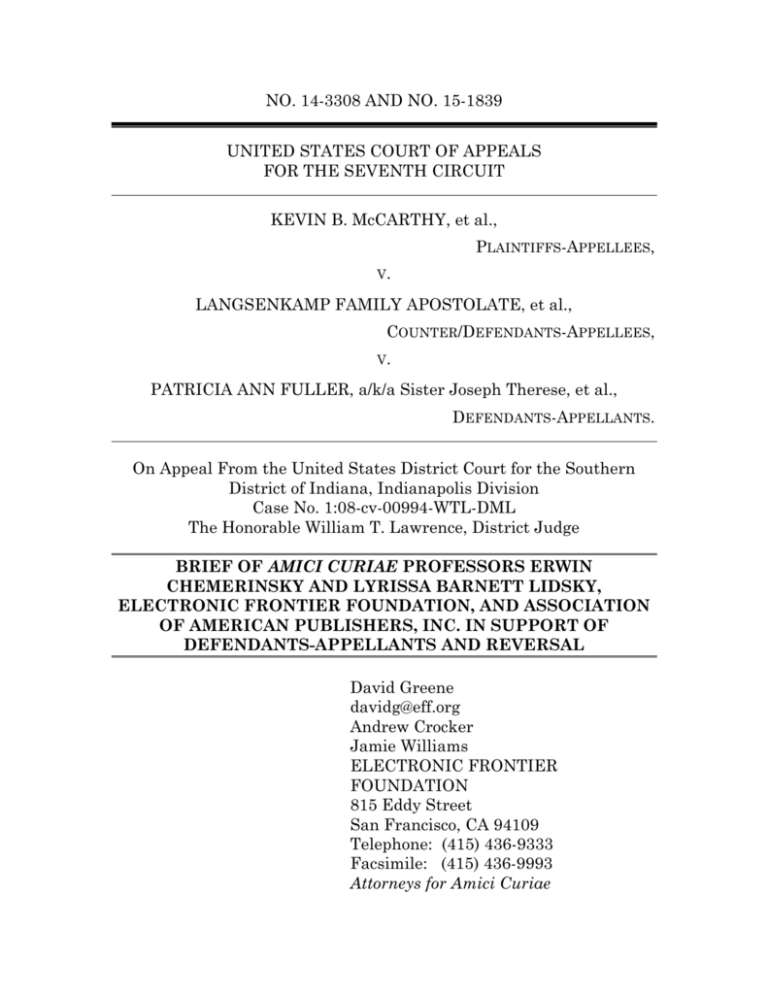
NO. 14-3308 AND NO. 15-1839 UNITED STATES COURT OF APPEALS FOR THE SEVENTH CIRCUIT KEVIN B. McCARTHY, et al., PLAINTIFFS-APPELLEES, V. LANGSENKAMP FAMILY APOSTOLATE, et al., COUNTER/DEFENDANTS-APPELLEES, V. PATRICIA ANN FULLER, a/k/a Sister Joseph Therese, et al., DEFENDANTS-APPELLANTS. On Appeal From the United States District Court for the Southern District of Indiana, Indianapolis Division Case No. 1:08-cv-00994-WTL-DML The Honorable William T. Lawrence, District Judge BRIEF OF AMICI CURIAE PROFESSORS ERWIN CHEMERINSKY AND LYRISSA BARNETT LIDSKY, ELECTRONIC FRONTIER FOUNDATION, AND ASSOCIATION OF AMERICAN PUBLISHERS, INC. IN SUPPORT OF DEFENDANTS-APPELLANTS AND REVERSAL David Greene davidg@eff.org Andrew Crocker Jamie Williams ELECTRONIC FRONTIER FOUNDATION 815 Eddy Street San Francisco, CA 94109 Telephone: (415) 436-9333 Facsimile: (415) 436-9993 Attorneys for Amici Curiae RULE 26.1 DISCLOSURE STATEMENT For the purposes of this case, the Electronic Frontier Foundation represents Amici Curiae Professor Erwin Chemerinsky, an individual, Professor Lyrissa Barnett Lidsky, an individual, the Electronic Frontier Foundation, a non-profit public advocacy organization, and the Association of American Publishers, Inc., a non-profit trade association (collectively, “Amici”). None of Amici have appeared earlier in this case, and for this brief, Amici are represented only by the Electronic Frontier Foundation. No attorney from any other organization or law firm has appeared, or is expected to appear, on behalf of Amici in this case. Both the Electronic Frontier Foundation and the Association of American Publishers, Inc. hereby state that they have no parent companies, subsidiaries, or affiliates, and that they do not issue shares to the public. Dated: June 30, 2015 By: /s/ David Greene _ David Greene ELECTRONIC FRONTIER FOUNDATION Counsel of Record for Amici Curiae pursuant to Circuit Rule 3(d) -i- TABLE OF CONTENTS RULE 26.1 DISCLOSURE STATEMENT ...................................... i INTEREST OF AMICI CURIAE...................................................... 1 INTRODUCTION ............................................................................. 4 ARGUMENT ..................................................................................... 6 I. Injunctions Against Defamatory Speech Are Unconstitutional Prior Restraints. .................................... 6 A. Injunctions Against Future Defamatory Speech Are Prior Restraints. ............................................... 7 B. The Injunction Issued by the District Court Is an Unconstitutional Prior Restraint. ........................ 11 1. Injunctions Limited to Statements That Have Been Adjudicated Defamatory Are Both Ineffective and Unconstitutional. .................. 12 a. Injunctions Against Specific Statements Cannot Be an Effective Remedy. ............ 14 b. Injunctions Against Specific Statements Are Unconstitutional Because Defamation Is Inherently Context-Specific. ............... 15 c. The Supreme Court’s Obscenity Jurisprudence Is Not Applicable Outside of the Category. ....................................... 18 2. Effective Injunctions Are Inherently Overinclusive. ................................................. 21 C. Damages Are the Proper Remedy for Defamation. ............................................................ 25 II. The Role of the Internet in Defamation Cases Does Not Affect the Constitutional Analysis of Injunctions. .......... 28 -i- CONCLUSION ................................................................................ 33 CERTIFICATE OF COMPLIANCE...............................................34 CERTIFICATE OF FILING AND SERVICE................................35 - ii - TABLE OF AUTHORITIES Cases Aafco Heating & Air Conditioning Co. v. Northwest Publ’ns, Inc., 321 N.E.2d 580 (Ind. Ct. App. 1974) ........................................... 16 ACLU v. Reno, 31 F. Supp. 2d 473 (E.D. Pa. 1999) ............................................. 29 Alexander v. United States, 509 U.S. 544 (1993).................................................................. 7, 15 Ashcroft v. ACLU, 535 U.S. 564 (2002)...................................................................... 29 Ashcroft v. Free Speech Coalition, 535 U.S. 234 (2002)...................................................................... 22 Balboa Island Village Inn, Inc. v. Lemen, 156 P.3d 339 (Cal. 2007) ...................................................... passim Bantam Books, Inc. v. Sullivan, 372 U.S. 58 (1963)........................................................................ 12 Brown v. Entm’t Merch. Ass’n, 131 S. Ct. 2729 (2011) ................................................................. 31 Burbage v. Burbage, 447 S.W.3d 249 (Tex. Aug. 29, 2014) .................................... 10, 11 Citizens United v. Fed. Election Comm’n, 558 U.S. 310 (2010)...................................................................... 28 Citizens’ Light, Heat & Power Co. v. Montgomery Light & Water Power Co., 171 F. 553 (C.C.M.D. Ala. 1909). ................................................ 28 e360 Insight v. The Spamhaus Project, 500 F.3d 594 (7th Cir. 2007) ......................................................... 6 Gertz v. Robert Welch, Inc., 418 U.S. 323 (1974)...................................................................... 25 Hamilton v. Prewett, 860 N.E.2d 1234 (Ind. Ct. App. 2007) ......................................... 25 - iii - Hartman v. Keri, 883 N.E.2d 774 (Ind. 2008) ................................................... 16, 18 Hill v. Petrotech Resources Corp., 325 S.W.3d 302 (Ky. 2010) .......................................................... 13 Hustler Magazine v. Falwell, 485 U.S. 46 (1982)........................................................................ 17 Kingsley Books, Inc. v. Brown, 354 U.S. 436 (1957)...................................................................... 19 Kinney v. Barnes, 443 S.W.3d 87 (Tex. Aug. 29, 2014) ..................................... passim Lamont v. Postmaster General, 381 U.S. 301 (1965)...................................................................... 24 Lothschuetz v. Carpenter, 898 F.2d 1200 (6th Cir. 1990) ..................................................... 13 Med. Informatics Eng’g, Inc.,v. Orthopaedics Northeast, P.C., 458 F. Supp. 2d 716 (N.D. Ind. 2006) ......................................... 17 Metropolitan Opera Ass’n, Inc. v. Local 100, 239 F.3d 172 (2d Cir. 2001) ........................................................... 6 Milkovich v. Lorain Journal Co., 497 U.S. 1 (1990).......................................................................... 23 Near v. Minnesota ex rel. Olson, 283 U.S. 697 (1931)............................................................... passim Neb. Press Ass’n v. Stuart, 427 U.S. 539 (1976)............................................................ 6, 11, 32 New York Times v. Sullivan, 376 U.S. 254 (1964)............................................................... 25, 32 New York Times v. United States, 403 U.S. 713 (1971)...................................................................... 14 Oakley, Inc. v. McWilliams, 879 F. Supp. 2d 1087 (C.D. Cal. 2010) ........................... 14, 17, 22 Organization for a Better Austin v. Keefe, 402 U.S. 415 (1971).................................................................... 8, 9 - iv - Pittsburgh Press Co. v. Human Rel. Comm’n, 413 U.S. 376 (1973)................................................................ 19, 20 Reno v. ACLU, 521 U.S. 844 (1997).......................................................... 28, 29, 30 Southeastern Promotions, Ltd. v. Conrad, 420 U.S. 546 (1975)...................................................................... 21 Tory v. Cochran, 544 U.S. 734 (2005)........................................................................ 6 United States v. Alvarez, 132 S. Ct. 2537 (2012) ..................................................... 29, 31, 33 United States v. Cassidy, 814 F. Supp. 2d 574 (D. Md. 2011) ............................................. 30 Vance v. Universal Amusement Co., 445 U.S. 308 (1980)........................................................................ 9 Wernsing v. Thompson, 423 F.3d 732 (7th Cir. 2005) ....................................................... 24 Other Authorities Lyrissa Barnett Lidsky, Silencing John Doe: Defamation and Discourse in Cyberspace, 49 Duke L.J. 855 (2000) .................... 32 Yochai Benkler, The Wealth of Networks (2006) ........................... 30 -v- INTEREST OF AMICI CURIAE1 Professor Erwin Chemerinsky is the founding Dean and Distinguished Professor of Law, and Raymond Pryke Professor of First Amendment Law, at the University of California, Irvine School of Law. He has frequently argued matters of constitutional law in front of the nation’s highest courts, including a United States Supreme Court decision involving injunctions in defamation cases, Tory v. Cochran, 544 U.S. 734 (2005). He also authored a widely cited law review article on the subject, Injunctions in Defamation Cases, 57 Syracuse L. Rev. 157 (2007). Professor Lyrissa Barnett Lidsky is the Stephen O’Connor Professor of Law and Associate Dean for International Programs at the Levin College of Law at the University of Florida. Professor Lidsky is the author of three casebooks: Torts, Mass Media Law, No party or party’s counsel has authored this brief in whole or in part, or contributed money that was intended to fund preparing or submitting the brief. No person has contributed money that was intended to fund preparing or submitting the brief. Defendants-Appellants Patricia Ann Fuller and Paul M. Hartman consent to the filing of this brief, while Appellees’ counsel have indicated that they intend to file an opposition to submission of the brief. 1 -1- and First Amendment Law. She has also written extensively on issues of Internet free speech, cyberbullying, and defamation and other privacy torts, including Silencing John Doe: Defamation and Discourse in Cyberspace, 49 Duke L.J. 855 (2000). The Electronic Frontier Foundation (“EFF”) is a membersupported, non-profit civil liberties organization that has worked to protect free speech and privacy rights in the online world for roughly 25 years. With roughly 22,000 active donors and duespaying members nationwide, EFF represents the interests of technology users in both court cases and broader policy debates surrounding the application of law in the digital age. EFF is especially concerned about laws and regulations that threaten free expression over the Internet. EFF views the protections provided by the First Amendment as vital to the promotion of a robustly democratic society. As part of its mission, EFF frequently serves as Amicus in First Amendment cases involving online speech. The Association of American Publishers, Inc. (“AAP”)—a non-profit New York corporation with offices in New York, Washington, and Philadelphia—is the national association of the -2- U.S. book publishing industry. AAP’s members include most of the major commercial book publishers in the United States, as well as smaller and non-profit publishers, university presses, and scholarly societies. AAP members publish hardcover and paperback books in every field, scholarly and professional journals, educational materials for the elementary, secondary, postsecondary, and professional markets, computer software, and electronic products and services. AAP represents an industry whose very existence depends upon the free exercise of rights guaranteed by the First Amendment. -3- INTRODUCTION Professor Erwin Chemerinsky, Professor Lyrissa Barnett Lidsky, EFF, and AAP (collectively, “Amici”)—experts in First Amendment and Internet law—respectfully submit this brief in support of Defendants-Appellants Patricia Ann Fuller and Paul M. Hartman (“Appellants”) to address an issue the district court in this case hinted at but neglected to address2: Does the First Amendment permit permanent injunctions against speech that has been found to be defamatory? Amici urge this Court to follow the long-held rule that “equity will not enjoin a libel” and reverse the permanent injunction entered by the district court. Injunctions against libelous speech, even after a final judicial determination, are prior restraints and cannot withstand the rigorous scrutiny due such orders. The richness of the English language and the myriad ways of expressing any given thought make it impossible for a trial court to craft an injunction against future defamatory speech that is both effective and that does not also bar the publication of 2 See Entry on Post-Trial Motions, ECF No. 854, at 11 n.7. -4- constitutionally protected speech. Moreover, defamation is inherently contextual, so even a permanent injunction limited to the exact words found to be defamatory in one context might prohibit speech that would not be actionable in another. This Court should reject any suggestion that the advent of Internet publication somehow undermines bedrock First Amendment protections. If anything, the particular properties of the Internet, which allow for the rapid flow of information, further counsel against allowing permanent injunctions in defamation cases. Given these constitutional flaws, as well as the significant concerns regarding judicial administration of an injunction against defamatory speech, damages are properly the exclusive remedy in defamation cases. Amici urge the Court to hold that even where a statement has been adjudicated false and defamatory, the First Amendment bars a permanent injunction against republication of the statement. Hence, this Court should vacate the permanent injunction issued by the district court in this case. -5- ARGUMENT I. INJUNCTIONS AGAINST FUTURE DEFAMATORY SPEECH ARE UNCONSTITUTIONAL PRIOR RESTRAINTS. Courts have historically and consistently held that “equity will not enjoin a libel.” Metropolitan Opera Ass’n, Inc. v. Local 100, 239 F.3d 172, 177 (2d Cir. 2001) (citing cases, including Neb. Press Ass’n v. Stuart, 427 U.S. 539, 559 (1976)). The rule is one of long standing, and it has gained a constitutional dimension under modern First Amendment jurisprudence.3 Even speech that is “unprotected” by the First Amendment cannot be subjected to a prior restraint without a separate holding that the prior restraint is constitutionally permissible. To rule otherwise would be to ignore the “well-established distinction” between permissible In 2005, the Supreme Court agreed to hear a case raising the question of whether the First Amendment permitted an injunction in a defamation case, but after the death of the plaintiff, the Court dissolved the injunction because it had “lost its underlying rationale.” Tory v. Cochran, 544 U.S. 734, 737-38 (2005). Similarly, although this Court has not squarely addressed the availability of injunctions in defamation cases, it has noted that the question presents “sensitive First Amendment issues” and vacated such an injunction as overbroad. e360 Insight v. The Spamhaus Project, 500 F.3d 594, 605-06 (7th Cir. 2007). 3 -6- “subsequent punishment” of speech that is found, after a trial, to be defamatory, and impermissible prior restraint of future speech. Alexander v. United States, 509 U.S. 544, 548 (1993); id. at 554 (“[W]e have interpreted the First Amendment as providing greater protection from prior restraints than from subsequent punishments[.]”). A. Injunctions Against Future Defamatory Speech Are Prior Restraints. Any injunction that restrains a defendant in a defamation case from making certain statements in the future is a prior restraint on speech. The Supreme Court has expressly declared that “permanent injunctions—i.e., court orders that actually forbid speech activities—are classic examples of prior restraints” because they impose a “true restraint on future speech.” Alexander, 509 U.S. at 550. The seminal case concerning prior restraints is Near v. Minnesota ex rel. Olson, 283 U.S. 697 (1931). In Near, a newspaper appealed a permanent injunction issued after a case “came on for trial.” Id. at 705. The injunction “perpetually” prevented the defendants from publishing again on account of the -7- lower court’s determination, after trial, that the defendant’s newspaper was “chiefly devoted to malicious, scandalous and defamatory articles.” Id. at 706 (quotations omitted). The Near Court held that such an injunction on future speech, even if preceded by the publication of defamatory material, was unconstitutional. 283 U.S. at 721. In Organization for a Better Austin v. Keefe, 402 U.S. 415 (1971), a group of picketers and pamphleteers were enjoined from protesting a real estate developer’s business practices.4 The Court struck down the injunction as “an impermissible restraint on First Amendment rights.” Id. at 418. The injunction was premised in part on the lower court’s finding that the protestors had invaded Keefe’s privacy by disclosing his home phone number and urging others to call him. Id. at 417. The Court held that the “claim that the expressions were intended to exercise a coercive impact on Although the Court noted that the injunction in Keefe was labeled “temporary” by the trial court, it was treated as permanent because its label was “little more than a formality,” it had been in effect for years, it had been issued after an “adversary hearing,” and it “already had [a] marked impact on petitioners’ First Amendment rights.” Keefe, 402 U.S. at 417-18 & n.1. 4 -8- respondent does not remove them from the reach of the First Amendment.” Id. at 419. The Court stressed that “[n]o prior decisions support the claim that the interest of an individual in being free from public criticism of his business practices in pamphlets or leaflets warrants use of the injunctive power of a court.” Id. In Vance v. Universal Amusement Co., 445 U.S. 308 (1980) (per curiam), the Court invalidated a Texas statute that authorized courts, upon a finding that the defendant had shown some obscene films in the past, to issue an injunction of indefinite duration prohibiting the defendant from showing any films in the future, even if those films had not yet been found to be obscene. Id. at 316-317. The three-judge District Court in Vance, whose decision was affirmed by the U.S. Supreme Court, held that, as in Near, “the state ‘made the mistake of prohibiting future conduct after a finding of undesirable present conduct,’” and that such a “general prohibition would operate as a prior restraint on unnamed motion pictures” in violation of the First Amendment. Id. at 311-12 & n.3, 316-17 (citation omitted). -9- Furthermore, last year, the Supreme Court of Texas addressed this exact question. The court held in two back-to-back opinions that permanent injunctions of future speech related to statements that have been adjudicated to be defamatory operate as impermissible prior restraints on free speech. Kinney v. Barnes, 443 S.W.3d 87, 89 (Tex. Aug. 29, 2014);5 Burbage v. Burbage, 447 S.W.3d 249, 263 (Tex. Aug. 29, 2014). In Kinney, a plaintiff filed a defamation lawsuit related to allegedly defamatory statements posted online and requested a permanent injunction on any similar future statements. Kinney, 443 S.W.3d at 89. The court found that the requested injunction on future speech was “the essence of prior restraint[.]” Id. at 93. According to the court, “an injunction prohibiting future speech based on [an adjudication that the speech is defamatory] impermissibly threatens to sweep The court in Kinney concluded that the injunction did not comply with the Texas Constitution, but noted that Texas law comports with the traditional First Amendment rule that injunctive relief is not available in defamation cases and that “[w]e know of nothing to suggest that injunctions restricting speech should be judged by a different standard under the state constitution than the First Amendment.” Id. at 91-92 (quoting Operation Rescue-Nat'l v. Planned Parenthood of Houston & Se. Texas, Inc., 975 S.W.2d 546, 559 (Tex. 1998)). 5 - 10 - protected speech into its prohibition and is an unconstitutional infringement on . . . free-speech rights.” Id. at 101. The very same day, in Burbage, the court struck down a permanent injunction issued by a trial court prohibiting any future defamatory speech related to ten defamatory statements at issue in the case—an injunction parallel to the injunction issued by the district court here—holding that such an “extraordinarily broad prohibition on future speech” was an impermissible prior restraint. Burbage, 447 S.W.3d 249 at 263.6 B. The Injunction Issued by the District Court Is an Unconstitutional Prior Restraint. Prior restraints are “the most serious and the least tolerable infringement on First Amendment rights.” Neb. Press Ass’n v. Stuart, 427 U.S. 539, 559 (1976). As a result, any prior restraint Despite the Supreme Court’s clear statements to the contrary, a handful of courts have found that an injunction issued in a defamation case is not a prior restraint if it follows a trial that determines that the speech in question was in fact defamatory. See, e.g., Balboa Island Village Inn, Inc. v. Lemen, 156 P.3d 339, 349 (Cal. 2007). However, despite this semantic distinction, the Balboa court subjected the injunction to a high level of scrutiny akin to the test for upholding a prior restraint. Id. at 348-349 (discussing narrow tailoring). 6 - 11 - “bear[s] a heavy presumption against its constitutional validity.” Bantam Books, Inc. v. Sullivan, 372 U.S. 58, 70 (1963). To pass constitutional muster, prior restraints must be necessary to further a governmental interest of the highest magnitude. See Neb. Press Ass’n, 427 U.S. at 562. The prior restraint will be necessary only if: (1) the harm to the governmental interest will definitely occur; (2) the harm will be irreparable; (3) no alternative exists for preventing the harm; and (4) the prior restraint will actually prevent the harm. See id. This test cannot be met in a defamation case. It is impossible to craft an injunction that is both efficacious and which does not include constitutionally protected speech within its reach. Any limited injunction will be both constitutionally suspect and ineffective, and any effective injunction will be inherently overinclusive. See id. 1. Injunctions Limited to Statements That Have Been Adjudicated Defamatory Are Both Ineffective and Unconstitutional. The handful of courts that have attempted to craft permissible prior restraints have taken an intentionally narrow, - 12 - but nonetheless faulty, approach: enjoining only the use of the specific words or statements found to be defamatory. These courts believe that there is no constitutional barrier to enjoining speech that has been fully and finally adjudicated to be defamatory. See Balboa, 156 P.3d at 352-55 (limiting the injunction to only those statements determined at trial to be defamatory, and to include exceptions, among others, that preserved the defendant’s right to “present[] her grievances to government officials”); Hill v. Petrotech Resources Corp., 325 S.W.3d 302, 313 (Ky. 2010) (limiting its injunction holding to “specific and particular statements” found “upon final adjudication of the trial court . . . to be false and defamatory;” see also Lothschuetz v. Carpenter, 898 F.2d 1200, 1209 (6th Cir. 1990) (Wellford, J., concurring in part and dissenting in part) (suggesting limiting possible injunctions to statements judicially found to be “false and libelous”). However, this approach is constitutionally problematic for several reasons. - 13 - a. Injunctions Against Specific Statements Cannot Be an Effective Remedy. Injunctions against the publication of specific words or statements fail the efficacy requirement of the prior restraint test. See New York Times v. United States, 403 U.S. 713, 744 (1971) (Marshall, J., concurring) (“a court of equity will not do a useless thing”). It is obvious that an injunction that is limited to preventing repetition of the specific statements already found to be defamatory is useless because a defendant can avoid its restrictions by making the same point using different words without violating the court’s order. See, e.g., Oakley, Inc. v. McWilliams, 879 F. Supp. 2d 1087, 1091 (C.D. Cal. 2010) (“Here, for instance, Plaintiffs seek to enjoin McWilliams from stating that Plaintiffs ‘sent thugs, Blackwater operatives, or military special forces to intimidate him.’ But this injunction would be worthless if McWilliams could instead simply claim that Plaintiffs had hired the mafia or a street gang to threaten him.”). If such rephrased statements are also defamatory, the plaintiff would return to court to get a similarly narrow injunction, leading to - 14 - revolving-door injunctions. See Neb. Press Ass’n, 427 U.S. at 565 (the court “must also assess the probable efficacy of [a] prior restraint of publication as a workable method,” and “cannot ignore the reality of the problems of managing” such orders).7 b. Injunctions Against Specific Statements Are Unconstitutional Because Defamation Is Inherently Context-Specific. Courts that have allowed injunctions limited to a republication of a statement found to be defamatory at trial are mistaken that they are enjoining “unprotected speech.” Balboa, 156 P.3d at 357 (quoting Ashcroft v. Free Speech Coalition, 535 U.S. 234, 255 (2000)). While a specific instance of defamation in the past is open to subsequent punishment, see Alexander, 509 U.S. at 554, defamation is also inherently context-specific and thus cannot be enjoined permanently. For example, a statement that is defamatory when published in one context at one point in These problems of judicial administration are likely even more acute with defamation on the Internet. If, as some argue, the spread of defamation online cannot be tamed with damages, it is clear that, given the wealth of platforms for online speech, an injunction would be ineffective in stopping this spread. 7 - 15 - time may not be defamatory in another context or at another time. Or it may be published or uttered in a manner that cloaks it with a privilege. Aafco Heating & Air Conditioning Co. v. Northwest Publ’ns, Inc., 321 N.E.2d 580, 583-4 (Ind. Ct. App. 1974) (fair comment privilege); Hartman v. Keri, 883 N.E.2d 774, 777 (Ind. 2008) (absolute judicial proceedings privilege). Despite the context-specific nature of defamation, permanent injunctions cannot account for changed circumstances. For example, a statement that was once false may become true later in time. Kinney, 443 S.W.3d at 98. Suppose a court, after finding that a defendant defamed a plaintiff by saying that the plaintiff blackmailed her, issues a permanent injunction against the defendant’s repeating any similar statements. If the plaintiff subsequently begins blackmailing the defendant, the defendant would remain enjoined from saying so, even though the statement would be true and hence constitutionally protected. Similarly, even if the statement remains false and the defendant initially acted with the requisite degree of culpability, a different level of culpability may be required in the future. In the - 16 - previous example, if the plaintiff later becomes a public figure, he will have to prove (a) actual malice and falsity, whereas previously he may only have had to demonstrate that the defendant published negligently, and (b) that the defendant could not prove the statements were true.8 Oakley, 879 F. Supp. 3d at 1091; Hustler Magazine v. Falwell, 485 U.S. 46, 52 (1982) (statements made about public figures are outside the scope of the First Amendment only when the plaintiff can “prove both that the statement was false and that the statement was made with the requisite level of culpability”) (emphasis in original). Finally, even if the underlying factual circumstances do not change, some publications of a defamatory statement may be nevertheless non-actionable. For instance, while it might be defamatory for the defendant to publish a newspaper story claiming the plaintiff blackmailed her, the absolute judicial Indiana requires only a showing of negligence if the plaintiff is a private figure and the defamation action does not involve a matter of public concern. Med. Informatics Eng’g, Inc.,v. Orthopaedics Northeast, P.C., 458 F. Supp. 2d 716, 721 n.3. (N.D. Ind. 2006). 8 - 17 - proceedings privilege would shield the same statement if made during the course of a trial. Hartman, 883 N.E.2d at 777. Crucially, if any of these examples of “changed circumstances” occur, the Balboa rule would require an enjoined defendant “to seek the trial court’s permission before she speaks by modifying the injunction.” Balboa, 156 P.3d at 357 (George, C.J., concurring) (characterizing the majority opinion). Shifting the burden onto the defendant in this way is “the essence of censorship,” which prior restraint doctrine forbids. Near, 283 U.S. at 713. All of these changes in circumstances and the corresponding level of First Amendment protection—from a matter of private concern to one of public concern, for example— can happen very rapidly. The First Amendment cannot tolerate restraints on now-protected speech while a court sorts out changed circumstances. c. The Supreme Court’s Obscenity Jurisprudence Is Not Applicable Outside of the Category. Courts adopting a rule allowing narrow injunctions base their holding on a misapplication of Supreme Court precedent - 18 - regarding other situations, not involving defamation, in which unprotected speech, particularly obscenity, can be subjected to a prior restraint in the form of an injunction. See Balboa, 156 P.3d at 346 (discussing Kingsley Books, Inc. v. Brown, 354 U.S. 436 (1957) and Pittsburgh Press Co. v. Human Rel. Comm’n, 413 U.S. 376 (1973)). These precedents are readily distinguishable. For example, in Kingsley Books, the Court explained that injunctions on materials already deemed obscene are “glaringly different” from the injunction of a publication “because its past issues had been found offensive.” 354 U.S. at 445. Reiterating Near’s admonition that the latter type of injunctions are the “essence of censorship,” the Kingsley Court “studiously withh[eld] restraint upon matters not already published and not yet found to be offensive.” Id. Pittsburgh Press, the other case relied on by the Balboa court, is also distinguishable based on the type of order involved. The case concerned a “narrowly drawn” rule by the Pittsburgh Commission on Human Relations prohibiting the “placement in sex-designated columns of advertisements for nonexempt job - 19 - opportunities.” 413 U.S. at 391. Despite upholding the order, the Supreme Court invoked Near and “reaffirm[ed] unequivocally the protection afforded to editorial judgment and to the free expression of views . . . however controversial.” Id. Furthermore, the Court stressed that the Commission’s order preventing sexbased want ads could not be enforced by contempt sanctions because “[t]he Commission is without power to punish summarily for contempt.” Id. at 390 n.14. This is entirely different from a permanent injunction issued by a court and backed up by the threat of sanctions for contempt. It may seem superficially consistent with Kingsley and other obscenity cases to allow injunctions against speech found to be defamatory, but the distinction lies in the form of the speech. Supreme Court precedent on obscenity “ha[s] never been read to authorize such broad limits on speech outside the category . . . . [T]he high court’s approval of injunctive relief for obscenity must be viewed in the larger context, in which it has permitted other forms of government regulation of obscene and sexually explicit speech that would likely be found unconstitutional if applied to - 20 - other forms of speech.” Balboa, 156 P.3d at 362 (Werdegar, J., concurring in part and dissenting in part); Kinney, 443 S.W.3d, at 97 (Kingsley rule does not extend to defamation). Thus, unlike injunctions on particular obscene motion pictures, enjoining “defamatory” speech will inherently reach too far because “[i]t is always difficult to know in advance what an individual will say, and the line between legitimate and illegitimate speech is often so finely drawn that the risks of freewheeling censorship are formidable.” Southeastern Promotions, Ltd. v. Conrad, 420 U.S. 546, 559 (1975). As discussed above, this is true even where an injunction is limited to the specific statement found at trial to be defamatory. 2. Effective Injunctions Are Inherently Overinclusive. In order to address the efficacy problem, some courts craft a broader injunction that includes not only specific words and phrases, but unspecified words and phrases that communicate the same ideas. That is, in fact, what the district court did in this case, permanently enjoining Appellants from publishing not only specific defamatory statements but also “any similar statements - 21 - that contain the same sorts of allegations or inferences, in any manner or forum.” See Amended Judgment, ECF No. 856, at 2. But these injunctions run headlong into the very problem the injunctions discussed above sought to avoid: they prohibit the publication of words and phrases that have not been specifically adjudicated to be defamatory or otherwise deserving of diminished First Amendment protection. As a result, these injunctions prohibit protected speech and are overinclusive. The First Amendment cannot allow “banning unprotected speech if a substantial amount of speech is prohibited or chilled in the process.” Ashcroft v. Free Speech Coalition, 535 U.S. 234, 255 (2002). Indeed, this was the very fault identified in Near. See 283 U.S. at 718-19. Such an injunction is overinclusive for the very reason that it restrains communication before a jury determination of whether it is or is not protected by the First Amendment. Because it delays communication that may be nondefamatory and protected by the First Amendment, is the essence of a prior restraint. See Oakley, 879 F. Supp. 2d at 1091 (defendant will have to “1) muzzle his or her now lawful speech, - 22 - while seeking and awaiting the court's permission to modify the injunction; or 2) speak freely, but risk potentially severe consequences if the court were to disagree about the lawfulness of the speech”). Moreover, any injunction that requires determining whether a defendant has implied something defamatory will “make it exceedingly difficult to determine whether a statement falls within [an injunction’s] parameters.” Kinney, 443 S.W.3d at 98. For example, the injunction will sweep in nonactionable speech, such as protected opinion or hyperbole, which may suggest or imply something actionable. Cf. Milkovich v. Lorain Journal Co., 497 U.S. 1, 20 (1990). As Justice Kennard explained dissenting in Balboa, it is impossible to formulate an effective injunction that would not be extremely overinclusive and that would not place the court in the role of the censor, continually deciding what speech is allowed and what is prohibited. Balboa, 156 P.3d at 354-57 (Kennard, J., dissenting). It is an inescapable conclusion, therefore, that an injunction in a defamation case is an unconstitutional prior - 23 - restraint no matter how it is crafted. Indeed, as the Texas Supreme Court noted in Kinney, “[t]rial courts are simply not equipped to comport with the constitutional requirement not to chill protected speech in an attempt to effectively enjoin defamation.” 443 S.W.3d at 99. Finally, overinclusive injunctions also harm the public, which has a right to receive protected information. Lamont v. Postmaster General, 381 U.S. 301, 307 (1965). As this Court has recognized, “purely as a matter of First Amendment freedoms, the public ramifications of a prior restraint on speech [may be far more] severe. Unlike ex post reprisals for speech activity, a prospective restriction ‘chills potential speech before it happens,’ depriving the public of information that might otherwise be disseminated.” Wernsing v. Thompson, 423 F.3d 732, 746-47 (7th Cir. 2005) (citation omitted). This concern is especially strong where, as here, defendants arguably forfeit their right to object to an overinclusive injunction due to procedural errors. See Entry on Post-Trial Motions, ECF No. 854, at 11. Indeed, the public has no forum to seek redress should a defendant waive or otherwise fail - 24 - to contest an overinclusive injunction. As such, not only are trial courts unequipped to constitutionally and effectively administer injunctions against future defamation, but the public interest counsels against the use of such injunctions. C. Damages Are the Proper Remedy for Defamation. Precluding prior restraints does not leave those defamed without remedy. Successful defamation plaintiffs have the ability to recover damages, in some cases without proving that they suffered any injury. Hamilton v. Prewett, 860 N.E.2d 1234, 1243 (Ind. Ct. App. 2007) (presumed damages available in defamation per se cases). In New York Times v. Sullivan, the Supreme Court stressed that damage awards, even against major metropolitan newspapers, are a potent weapon for the defamation plaintiff and noted that “[t]he fear of damage awards . . . may be markedly more inhibiting than the fear of prosecution under a criminal statute.” 376 U.S. 254, 277-78 (1964). In the case of private individuals, the Constitution places a lower bar to the recovery of damages. See Gertz v. Robert Welch, Inc., 418 U.S. 323, 343, 350 (1974). Moreover, in an action for damages brought based on - 25 - repeated behavior, the plaintiff will presumably have an easier time making a case, even where she is required to demonstrate actual malice. The Supreme Court’s precedent makes clear that in light of the dangers of prior restraints, damages are the correct remedy in a defamation case. In Near, the Court drew a line between damages as a permissible remedy for past speech and an impermissible system that proscribes future speech: “Public officers, whose character and conduct remain open to debate and free discussion in the press, find their remedies for false accusations in actions under libel laws providing for redress and punishment, and not in proceedings to restrain the publication of newspapers and periodicals.” Near, 283 U.S. at 718-19. The minority of courts that have allowed the issuance of injunctions in defamation cases have pointed to the possibility that damages are insufficient to deter very poor, “judgment proof” defendants, or very rich defendants for whom damages are a mere annoyance. Balboa, 156 P.3d at 351. These courts posit that - 26 - absent an injunction, they will be powerless to stop such individuals from repeatedly defaming a helpless plaintiff. Id. As a preliminary matter, this is a troubling argument, since it potentially links defendants’ constitutional protections to their relative financial status. There is no precedent for such disparate treatment. Moreover, it is doubtful that such a person would be deterred by the threat of contempt and fines. A judgment-proof serial defamer will likely be as disinclined to pay a contempt fine as he would a damages award. Finally, it casts the Court in the role of speech-police, continually monitoring an enjoined defendant’s behavior. Ultimately, the traditional rule that equity will not enjoin a libel embodies a judgment that in order to preserve free speech, some objectionable statements cannot be prevented before they occur. “The wrongs and injury, which often occur from lack of preventive means to suppress slander, are parts of the price which the people, by their organic law, have declared it is better to pay, than to encounter the evils which might result if the courts were allowed to take the alleged slanderer or libeler by the throat, in - 27 - advance.” Citizens’ Light, Heat & Power Co. v. Montgomery Light & Water Power Co., 171 F. 553, 556 (C.C.M.D. Ala. 1909). II. THE ROLE OF THE INTERNET IN DEFAMATION CASES DOES NOT AFFECT THE CONSTITUTIONAL ANALYSIS OF INJUNCTIONS. The landscape of communication has been dramatically reshaped by the Internet. Americans rely on digital means of communication for nearly every conceivable purpose in their daily lives. The U.S. Supreme Court has recognized the Internet’s importance and made clear that it is entitled to the full protection of the First Amendment. Reno v. ACLU, 521 U.S. 844, 870 (1997) (finding “no basis for qualifying the level of First Amendment scrutiny that should be applied to [the Internet]”). In fact, the Supreme Court has taken a definitive stance guaranteeing equal protection for speech over the Internet, holding that “[w]e must decline to draw, and then redraw, constitutional lines based on the particular media or technology used to disseminate political speech from a particular speaker.” Citizens United v. Fed. Election Comm’n, 558 U.S. 310, 326 (2010). - 28 - Indeed, the Internet gives great power to the fundamental First Amendment axiom that “[t]he remedy for speech that is false is speech that is true.” United States v. Alvarez, 132 S. Ct. 2537, 2550 (2012).9 Because the cost of online speech is relatively low compared to traditional media, almost anyone can “speak her mind in the virtual village green to an audience larger and more diverse than any the Framers could have imagined.” ACLU v. Reno, 31 F. Supp. 2d 473, 476 (E.D. Pa. 1999), aff’d, 217 F.3d 162 (3d Cir. 2000), vacated sub nom. Ashcroft v. ACLU, 535 U.S. 564 (2002). As a result, the Internet is the natural home of the “lonely pamphleteer.” Reno v. ACLU, 521 U.S. at 870 (“Through the use of Web pages, mail exploders, and newsgroups . . . [an] individual can become a pamphleteer.”). The Internet is renowned for its capacity to enable and amplify a vast range of protected political The First Amendment embodies the Framers’ judgment that it should be “the ordinary course in a free society” to engage false speech with the truth. Alvarez, 132 S. Ct. at 2550. “The theory of our Constitution is ‘that the best test of truth is the power of the thought to get itself accepted in the competition of the market[.]’” Id. (quoting Abrams v. United States, 250 U.S. 616, 630 (1919) (Holmes, J., dissenting)). 9 - 29 - speech, from critiques of government excess to exposés on unsafe or illegal corporate practices. See generally Yochai Benkler, The Wealth of Networks 212-72 (2006) (discussing the emergence of the Internet as a tool of political expression by private individuals). Thus, just as networked technologies may facilitate the spread of defamatory speech, they can just as quickly allow that speech to be countered. Ironically, however, it is the very characteristics of the Internet that the Supreme Court in Reno v. ACLU found justified its full First Amendment protection—“the ease and speed by which any person can take on the role of the town crier or pamphleteer”—that often ignite calls for online speech to receive diminished protection. Kinney v. Barnes, 443 S.W.3d at 100; see, e.g., United States v. Cassidy, 814 F. Supp. 2d 574, 582 (D. Md. 2011) (online speech protected “[e]ven though the Internet is the newest medium for anonymous, uncomfortable expression”) (citing Reno v. ACLU, 521 U.S. at 870). The Supreme Court, however, has clearly stated that “whatever the challenges of applying the Constitution to ever-advancing technology, ‘the basic principles of - 30 - freedom of speech and the press, like the First Amendment’s command, do not vary’ when a new and different medium for communication appears.” Brown v. Entm’t Merch. Ass’n, 131 S. Ct. 2729, 2733 (2011). Some argue that defamatory online speech cannot be effectively countered with truthful speech. But this concern is not unique to the Internet, and it is arguably even less compelling in the context of the Internet given the rapid flow of information. Plaintiffs armed with a judgment against online defamatory speech can quickly and cheaply respond by posting a copy of the judgment. Moreover, in any medium, a plaintiff may be dissatisfied with “more speech” as a non-monetary remedy, but as the Supreme Court has held, under the First Amendment, dissatisfaction does not justify imposition of a prior restraint. Alvarez, 132 S. Ct. at 2550 (rejecting claim “that counterspeech is insufficient”). Injunctions against Internet defamation also risk stifling the robustness of political and social speech on the Internet. For example, when powerful entities are targeted for criticism, it is a - 31 - familiar tactic to answer with a lawsuit, regardless of legal merit. See Sullivan, 376 U.S. at 279 (expressing fear that absent First Amendment protection, “would-be critics of official conduct may be deterred from voicing their criticism”). Allowing an injunction in Internet defamation cases would give powerful entities a potential tool to harass their critics, chilling online discourse. See, e.g., Lyrissa Barnett Lidsky, Silencing John Doe: Defamation and Discourse in Cyberspace, 49 Duke L.J. 855, 888-89 (2000) (discussing chilling effects in online context); Nebraska Press Ass’n. v. Stuart, 427 U.S. 539, 559 (1976) (prior restraints, such as injunctions, “freeze” speech before it occurs). In its First Amendment jurisprudence, the Supreme Court has carefully shaped protections that ensure breathing space for free speech while allowing appropriate remedies against “unprotected” speech, such as speech that has been adjudicated as defamatory. These long-held rules are outlined above. Amici ask the Court to apply these pre-existing rules to the case at hand and reject any invitation to craft Internet-specific rules. - 32 - CONCLUSION As the U.S. Supreme Court has recently reaffirmed, the First Amendment requires that, at times, even demonstrably false speech not be suppressed. Alvarez, 132 S. Ct. at 2550. Courts should thus not alter the long-held rule barring injunctions in defamation cases out of a concern that damages are insufficient. Such a concern, while understandable, upsets a fundamental premise of the First Amendment. For the forgoing reasons, this Court should vacate the injunction issued by the district court in this case. Dated: June 30, 2015 Respectfully Submitted, /s/ David Greene _ David Greene Andrew Crocker Jamie Williams ELECTRONIC FRONTIER FOUNDATION 815 Eddy Street San Francisco, CA 94109 Telephone: (415) 436-9333 Facsimile: (415) 436-9993 davidg@eff.org Attorneys for Amici Curiae - 33 - CERTIFICATE OF COMPLIANCE 1. This brief complies with the type-volume limitation of Fed. R. App. P. 32(a)(7)(B) because this brief contains 5,843 words, excluding the parts of the brief exempted by Fed. R. App. P. 32(a)(7)(B)(iii). 2. This brief complies with the typeface requirements of Fed. R. App. P. 32(a)(5) and the type style requirements of Fed. R. App. P. 32(a)(6) because this brief has been prepared in a proportionally spaced typeface using Word 2011 in 14-point Century Schoolbook. Dated: June 30, 2015 /s/ David Greene _ David Greene ELECTRONIC FRONTIER FOUNDATION Attorneys for Amici Curiae -34- CERTIFICATE OF FILING AND SERVICE I hereby certify that on June 30, 2015, I electronically filed the foregoing with the Clerk of the Court for the United States Court of Appeals for the Seventh Circuit by using the CM/ECF system. I certify that all but one participants in the case are registered CM/ECF users and that service will be accomplished by the CM/ECF system. I further certify that I mailed the foregoing documents by First-Class Mail, postage prepaid, or have dispatched it to a third-party commercial carrier for delivery within three (3) calendar days, to the following non-CM/ECF participant: Larry Young P.O. Box 996 Kildeer, IL 60047 Dated: June 30, 2015 /s/ David Greene _ David Greene ELECTRONIC FRONTIER FOUNDATION Attorneys for Amici Curiae -35-
